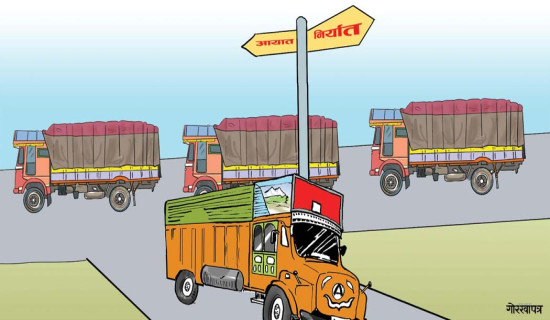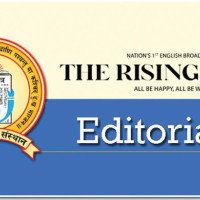- Tuesday, 23 December 2025
Managing Non-performing Loans
Since the outbreak of the COVID-19 pandemic, banks in Nepal have visibly faced challenges. The pandemic has impacted the economy as a whole with the result that the economic status of the people has gone downhill. As in other sectors, the banking sector has also taken a knock, especially in terms of lending. Lending is the sector where banks make heavy investments and on which their survival depends. Banks also make money through other segments such as letters of credit, guarantees, documentary credits and treasury transactions.
On the one hand, banks have not been able to disburse loans to a satisfactory degree, whereas on the other there are challenges in recovering loans. As a result, non-performing loans (NPLs) are growing in the banking sector. NPLs emerge when there are late payments on the part of loan clients or when the loans are unlikely to be repaid. An accumulation of NPLs hurts banks. NPLs reduce profitability. NPLs lead to a shrinkage in lending activities because of the money locked in such loans. When NPLs grow excessively, it may affect the economy as well, slowing down its pace.
Categories
In Nepal, loans are classified into five categories: good, watch list, substandard, doubtful and bad. Good loans are within the overdue period of thirty days. Watch-list loans fall into the overdue period of 31 to 90 days. Substandard loans are those whose overdue period ranges from 91 days to 180 days. The overdue period of doubtful loans is 181 days to 365 days. Any loan past one year is called a bad loan, which is most unlikely to be recovered. Banks are required to make provisioning as per the category: 1.1 per cent for good loans, 5 per cent for watch-list loans, 25 per cent for substandard loans, 50 per cent for doubtful loans and 100 per cent for bad loans. Loans that remain unrepaid for 90 days or more turn into NPLs.
Managing NPLs has become a daunting challenge for banks now. The directives of Nepal Rastra Bank allow banks to make provisioning for up to five per cent. Any loan amount above this threshold is subject to a corporate tax of 30 per cent. As of Poush-end, 2081, some banks had provisioning of more than five per cent. Among the twenty commercial banks, Himalayan Bank, Kumari Bank, Prabhu Bank, Nepal Investment Mega Bank and Prime Bank had more than five per cent of provisioning. It is reported that the banking sector has requested the NRB to review the provisioning and allow them to increase the threshold to seven per cent from five per cent.
Banks think that imposing a tax on the bad loan amount above the five per cent threshold vitiates their financial performance. On the one hand, they are unable to recover loans, while on the other they have to pay taxes, which is tantamount to a double whammy. However, the threshold cannot be revised right now. For this, the relevant provisions in the Income Tax Act need to be amended, which is a difficult proposition. Further, if banks recover loans already taxed, they will not have to pay additional taxes. It is ironic that despite the authority to recover loans by selling the relevant collateral, banks find it heavy to recover bad loans. Banks should, therefore, adopt a prudential methodology while disbursing loans.
There are mainly two approaches to dealing with NPLs. One is a decentralised approach, while the other is a centralised approach. Under the decentralised approach, banks have to manage bad loans themselves. They are regulated in such a way that they take measures to prevent NPLs from accumulating or resolving NLP issues. Such measures include the introduction of accounting rules that prevent banks from making provisioning against future losses or setting up legislation frameworks or other measures to develop secondary markets for NPLs. Selling bad loans in the secondary market may be lucrative for buying companies as such loans are up for grabs at a discount ranging from 1 to 80 per cent of the total loans and the companies can become legal owners.
Under the centralised approach, bad loans are managed through asset management companies, also called bad banks. Asset management companies use public or bank funds to remove NPLs from the books of accounts of banks. For example, the Korean Asset Management Corporation bought 80 per cent of bad loans at the market rate in the aftermath of the Asian crises.
Centralised approach
Although these approaches are available to troubled banks, both can be used simultaneously. Some experts suggest that the centralised approach is more effective at staving off systemic crises. However, it would be judicious for banks to take proactive measures to tackle NPLs. For this, the tendency on the part of some banks to undervalue NPLs to prevent their reputation from being tarnished in the market should be avoided. Banks should make their NPL reports transparent and avoid doctoring them. Likewise, they should adhere to the relevant directives of the NRB and accounting frameworks like the Nepal Financial Reporting Standards (NFRS).
As the regulatory body of banks, the NRB should conduct prudential supervision of distressed banks before it is too late. Such supervision may encapsulate capital adequacy requirements and buffers. NPLs increasing in the banking sector is a bad omen. However, it is not the problem that cannot be solved. The economy of the country is going through a bad patch now. After the restoration of the economy to good status down the road, there will be increased activity in the banking sector. Banks are also optimistic about this. That is why they have demanded that the threshold of NPLs be increased to seven per cent for some years.
(Maharjan has been regularly writing on contemporary issues for this daily since 2000.)

















